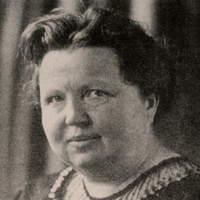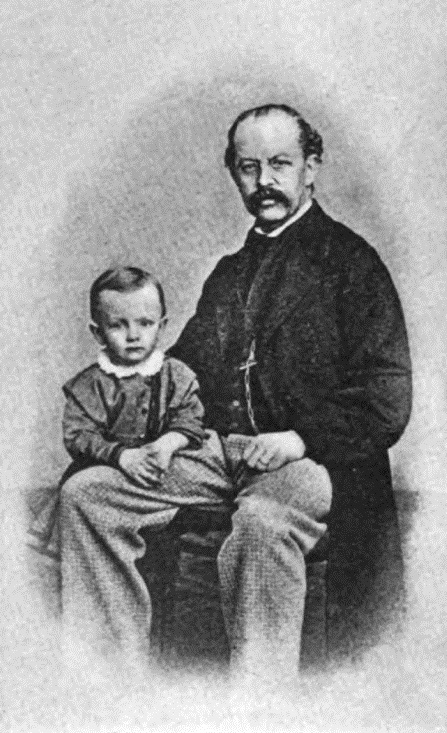|
Henni Lehmann
Henriette Lehmann, née Straßmann, known as Henni (10 October 1862, Berlin – 18 February 1937, Berlin) was a politically and socially active German painter and writer of Jewish ancestry. Biography Her father, Wolfgang Straßmann, was a doctor and social activist who, for many years, was a member of the Prussian House of Representatives.Brief biography @ Hiddensee Kultur. In 1888, while attending the Royal School of Art, she met and married , a legal scholar. After the wedding, they both converted to Protestantism and moved to , where he had been appointed a Professor at the |
Henni Lehmann
Henriette Lehmann, née Straßmann, known as Henni (10 October 1862, Berlin – 18 February 1937, Berlin) was a politically and socially active German painter and writer of Jewish ancestry. Biography Her father, Wolfgang Straßmann, was a doctor and social activist who, for many years, was a member of the Prussian House of Representatives.Brief biography @ Hiddensee Kultur. In 1888, while attending the Royal School of Art, she met and married , a legal scholar. After the wedding, they both converted to Protestantism and moved to , where he had been appointed a Professor at the |
Käthe Loewenthal
Käthe Frida Rosa Loewenthal (27 March 1878, in Berlin – 26 April 1942, in Izbica Ghetto, Izbica) was a German Modern art, Modernist landscape painter of Jewish ancestry. She was murdered in the The Holocaust, Shoah. The Painter Susanne Ritscher was her sister. Biography Her father Wilhelm Loewenthal was an ophthalmologist and hygienist. They moved frequently, living in Geneva, Lausanne, Paris and Berlin, as her father did work at various universities. The year 1890 found them in Bern, where she made friends with the family of a local pastor and converted to Protestantism.Time Line @ Art and Memory. [...More Info...] [...Related Items...] OR: [Wikipedia] [Google] [Baidu] |
19th-century German Jews
The 19th (nineteenth) century began on 1 January 1801 ( MDCCCI), and ended on 31 December 1900 ( MCM). The 19th century was the ninth century of the 2nd millennium. The 19th century was characterized by vast social upheaval. Slavery was abolished in much of Europe and the Americas. The First Industrial Revolution, though it began in the late 18th century, expanding beyond its British homeland for the first time during this century, particularly remaking the economies and societies of the Low Countries, the Rhineland, Northern Italy, and the Northeastern United States. A few decades later, the Second Industrial Revolution led to ever more massive urbanization and much higher levels of productivity, profit, and prosperity, a pattern that continued into the 20th century. The Islamic gunpowder empires fell into decline and European imperialism brought much of South Asia, Southeast Asia, and almost all of Africa under colonial rule. It was also marked by the collapse of the large ... [...More Info...] [...Related Items...] OR: [Wikipedia] [Google] [Baidu] |
1937 Suicides
Events January * January 1 – Anastasio Somoza García becomes President of Nicaragua. * January 5 – Water levels begin to rise in the Ohio River in the United States, leading to the Ohio River flood of 1937, which continues into February, leaving 1 million people homeless and 385 people dead. * January 15 – Spanish Civil War: Second Battle of the Corunna Road ends inconclusively. * January 20 – Second inauguration of Franklin D. Roosevelt: Franklin D. Roosevelt is sworn in for a second term as President of the United States. This is the first time that the United States presidential inauguration occurs on this date; the change is due to the ratification in 1933 of the Twentieth Amendment to the United States Constitution. * January 23 – Moscow Trials: Trial of the Anti-Soviet Trotskyist Center – In the Soviet Union 17 leading Communists go on trial, accused of participating in a plot led by Leon Trotsky to overthrow Joseph Stalin's regime, and assassinate ... [...More Info...] [...Related Items...] OR: [Wikipedia] [Google] [Baidu] |
1937 Deaths
Events January * January 1 – Anastasio Somoza García becomes President of Nicaragua. * January 5 – Water levels begin to rise in the Ohio River in the United States, leading to the Ohio River flood of 1937, which continues into February, leaving 1 million people homeless and 385 people dead. * January 15 – Spanish Civil War: Second Battle of the Corunna Road ends inconclusively. * January 20 – Second inauguration of Franklin D. Roosevelt: Franklin D. Roosevelt is sworn in for a second term as President of the United States. This is the first time that the United States presidential inauguration occurs on this date; the change is due to the ratification in 1933 of the Twentieth Amendment to the United States Constitution. * January 23 – Moscow Trials: Trial of the Anti-Soviet Trotskyist Center – In the Soviet Union 17 leading Communists go on trial, accused of participating in a plot led by Leon Trotsky to overthrow Joseph Stalin's regime, and assa ... [...More Info...] [...Related Items...] OR: [Wikipedia] [Google] [Baidu] |
1862 Births
Year 186 ( CLXXXVI) was a common year starting on Saturday (link will display the full calendar) of the Julian calendar. At the time, it was known as the Year of the Consulship of Aurelius and Glabrio (or, less frequently, year 939 ''Ab urbe condita''). The denomination 186 for this year has been used since the early medieval period, when the Anno Domini calendar era became the prevalent method in Europe for naming years. Events By place Roman Empire * Peasants in Gaul stage an anti-tax uprising under Maternus. * Roman governor Pertinax escapes an assassination attempt, by British usurpers. New Zealand * The Hatepe volcanic eruption extends Lake Taupō and makes skies red across the world. However, recent radiocarbon dating by R. Sparks has put the date at 233 AD ± 13 (95% confidence). Births * Ma Liang, Chinese official of the Shu Han state (d. 222) Deaths * April 21 – Apollonius the Apologist, Christian martyr * Bian Zhang, Chinese official and gene ... [...More Info...] [...Related Items...] OR: [Wikipedia] [Google] [Baidu] |
Humboldt University
Humboldt-Universität zu Berlin (german: Humboldt-Universität zu Berlin, abbreviated HU Berlin) is a German public research university in the central borough of Mitte in Berlin. It was established by Frederick William III on the initiative of Wilhelm von Humboldt, Johann Gottlieb Fichte and Friedrich Ernst Daniel Schleiermacher as the University of Berlin () in 1809, and opened in 1810, making it the oldest of Berlin's four universities. From 1828 until its closure in 1945, it was named Friedrich Wilhelm University (german: Friedrich-Wilhelms-Universität). During the Cold War, the university found itself in East Berlin and was ''de facto'' split in two when the Free University of Berlin opened in West Berlin. The university received its current name in honour of Alexander and Wilhelm von Humboldt in 1949. The university is divided into nine faculties including its medical school shared with the Freie Universität Berlin. The university has a student enrollment of around 32,0 ... [...More Info...] [...Related Items...] OR: [Wikipedia] [Google] [Baidu] |
Gerhart Hauptmann
Gerhart Johann Robert Hauptmann (; 15 November 1862 – 6 June 1946) was a German dramatist and novelist. He is counted among the most important promoters of literary naturalism, though he integrated other styles into his work as well. He received the Nobel Prize in Literature in 1912. Life Childhood and youth Gerhart Hauptmann was born in 1862 in Obersalzbrunn, now known as Szczawno-Zdrój, in Lower Silesia (then a part of the Kingdom of Prussia, now a part of Poland). His parents were Robert and Marie Hauptmann, who ran a hotel in the area. As a youth, Hauptmann had a reputation of being loose with the truth. His elder brother was Carl Hauptmann. Beginning in 1868, he attended the village school and then, in 1874, the Realschule in Breslau for which he had only barely passed the qualifying exam. Hauptmann had difficulties adjusting himself to his new surroundings in the city. He lived, along with his brother Carl, in a somewhat run-down student boarding house before fin ... [...More Info...] [...Related Items...] OR: [Wikipedia] [Google] [Baidu] |
Hiddensee Asv2022-08 Img23 Vitte Blaue Scheune
Hiddensee () is a car-free island in the Baltic Sea, located west of Germany's largest island, Rügen, on the German coast. The island has about 1,000 inhabitants. It was a holiday destination for East German tourists during German Democratic Republic (GDR) times, and continues to attract tourists today. It is the location of the University of Greifswald's ornithological station. Gerhart Hauptmann and Walter Felsenstein are buried there. Name The name ''Hedinsey'' surfaces as early as the ''Prose Edda'' and the ''Gesta Danorum'' written by Saxo Grammaticus and means "Island of Hedin". The legendary Norwegian king, Hedin, was supposed to have fought here for a woman or even just for gold. Under Danish rule the name ''Hedins-Oe'' ("Hedin's Island") was common. Even in 1880 the island was shown in German maps as ''Hiddensjö'' and, in 1929, in German holiday guides as ''Hiddensöe''. Its full Germanization to ''Hiddensee'' is thus relatively recent. Geography Hiddensee is ... [...More Info...] [...Related Items...] OR: [Wikipedia] [Google] [Baidu] |








